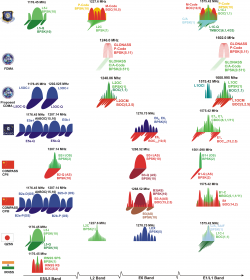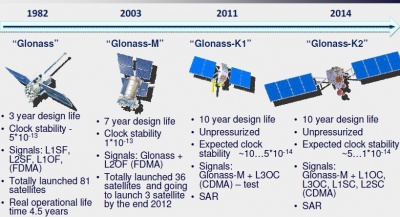If you wish to contribute or participate in the discussions about articles you are invited to contact the Editor
GLONASS Future and Evolutions: Difference between revisions
Jorge.Moran (talk | contribs) mNo edit summary |
Jorge.Moran (talk | contribs) |
||
| Line 18: | Line 18: | ||
==Signal Modernization== | ==Signal Modernization== | ||
[[File:Galileo Signals in Space.png| | [[File:Galileo Signals in Space.png|250px|GNSS Signal Frequencies|right|thumb]] | ||
Traditionally, GLONASS satellites transmits navigational radiosignals on two frequency sub-bands (L1 ~ 1602 MHz and L2 ~ 1246 MHz), relying on the Frequency Division Multiple Access (FDMA) technique in contrast to CDMA employed by all the other GNSS systems. | Traditionally, GLONASS satellites transmits navigational radiosignals on two frequency sub-bands (L1 ~ 1602 MHz and L2 ~ 1246 MHz), relying on the Frequency Division Multiple Access (FDMA) technique in contrast to CDMA employed by all the other GNSS systems. | ||
Revision as of 13:54, 6 July 2011
| GLONASS | |
|---|---|
| Title | GLONASS Future and Evolutions |
| Author(s) | GMV |
| Level | Basic |
| Year of Publication | 2011 |
In 2001, there were only seven GLONASS operational satellites in orbit. Acknowledging that navigation satellite system GLONASS was a top priority, the Government of the Russian Federation, by its Decree No. 587 of 20 August 2001, approved a Federal Task Program on the Global Navigation System (GNS) [1]. The GNS Program covers improvement of space, ground-based and user equipment segments of the GLONASS system.
One of the main objectives of the Program is to ensure GLONASS performance similar to GPS by the end of 2011. GLONASS poorer performance is the culmination of several factors:[2]
- poorer on-board atomic clocks
- less stability and predictability in the satellite orbits (and therefore less accuracy in GLONASS broadcast ephemerides)
- fewer satellites providing signals
- operational control and ground monitoring segment limited to Russian territory,
The Program is scheduled to end in 2011, however the Federal Spacy Agency has already announced that the maintenance and development of GLONASS will be extended until 2020, and will cost 402 billion rubles ($14.35 billion).[3]
Signal Modernization
Traditionally, GLONASS satellites transmits navigational radiosignals on two frequency sub-bands (L1 ~ 1602 MHz and L2 ~ 1246 MHz), relying on the Frequency Division Multiple Access (FDMA) technique in contrast to CDMA employed by all the other GNSS systems.
Aiming to provide better accuracy, multipath resistance and especially, greater interoperability with GPS and future GALILEO and other GNSS Systems, new GLONASS-K satellites will transmit CDMA signals in addition to the system’s traditional FDMA. In fact, since the successful launch of the first GLONASS K1 satellite, [4], a new L3 CDMA signal is already being transmitting and tracked by several receiver companies. The GLONASS L3 signal is centered at 1207.14 MHz, the same frequency as Galileo/COMPASS signal E5b, in the region allocated to the Aeronautical Radio 1 Navigation Service (ARNS). These bands are especially suitable for Safety-of-Life applications because no other users are allowed to interfere with their signals.
The future GLONASS K2 satellites to be launched in 2013, will feature three additional CDMA signals near the original FDMA frequencies, one obfuscated signal located at 1242 MHz in the L2 band, as well as two signals at 1575.42 MHz in the L1 band.
A modernized GLONASS-K satellite, GLONASS-KM, for launch after 2015 [5] may also transmit on the GPS L5 frequency at 1176.45 MHz, the same as the modernized GPS signal "Safety of Life" (L5) and Galileo signal E5a.
Space Segment
GLONASS Space Segment modernization, began with the second generation of satellites, GLONASS-M. These satellites use previously reserved bytes in the navigation message to provide additional information, including the divergence of GPS and GLONASS time scales, navigation frame authenticity (validity) flags, and age of data information.[6] Moreover, improved filters were installed to reduce out-of-band emissions and on-board clock stability over 24 hours was improved from 5x10-13 to 1x10-13.
The first satellite of the third generation, GLONASS-K1, was launched on February 26 2011. GLONASS-K1 satellites have a 10-year design life and carry a CDMA civil signal at L3 frequency in the 1205 MHz band.
A completely new design, GLONASS-K2, will start launching in 2013. GLONASS-K2 satellites will have a 10-year design life and a clock stability of 1x10-14. Besides the CDMA signals on L3, CDMA signals will also be transmitted on L1 and L2. The GLONASS-K satellites will transmit the legacy FDMA satellites in addition to the CDMA signals.
A modernized GLONASS-K satellite, GLONASS-KM, for launch after 2015 is now under study. In addition to transmitting legacy FDMA signals on L1 and L2 and CDMA signals on L1, L2, and L3, CDMA signals may also be transmitted on the GPS L5 frequency at 1176.45 MHz.Plans for GLONASS-K include providing GNSS integrity information in the third civil signal and global differential ephemeris and time corrections. [6] Also being studied is an alternative to the present three-plane, equally spaced satellite constellation. This new constellation design would require that the legacy FDMA signals be switched off.[5]
Notes
References
- ^ Federal Task Program on the Global Navigation System
- ^ Russia Dwells on Glonass Future, InsideGNSS
- ^ GLONASS, Galileo Finances Star at Paris Air Show, InsideGNSS
- ^ Russia’s First GLONASS-K In Orbit, CDMA Signals Coming, insideGNSS
- ^ a b GLONASS Update Delves into Constellation Details, GPSworld
- ^ a b GLONASS: The Once and Future GNSS, InsideGNSS


